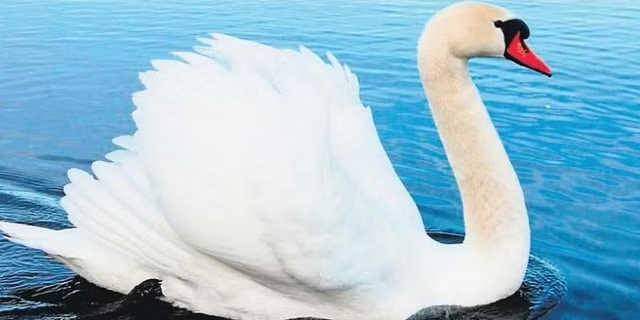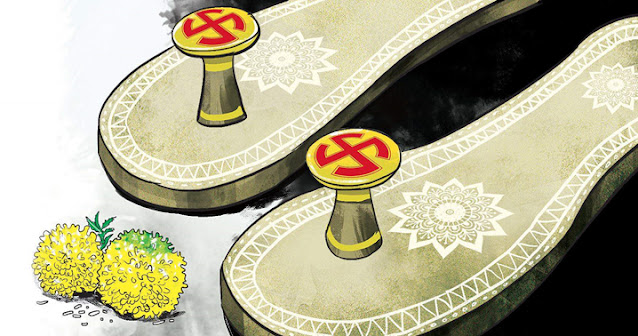Palmyra leaf bags substitute plastic nursery bags to support sustainable mangrove restoration
by M.T. Saju
- An experiment in Tamil Nadu notes the success of nursery bags made of palmyra over those made of plastic, for the nurturing and transplantation of mangrove seedlings during ecological restoration activities.
- Mangrove seedlings showed good growth like they did in plastic bags and higher durability against water inundation. They were also able to spread roots better in palmyra bags.
- Traditional crafts involving palmyra leaves constitute an important source of livelihood for locals in the district of Thanjavur.
Sitting near her thatched hut, Achikkannu reaches for a set of dried palmyra (Borassus flabellifer) leaves kept on a fence, made of broken fishing nets. She cuts the leaves into equal parts. Despite her struggles with frequent bouts of flu, she can weave a nursery bag in 40 minutes with dried palmyra leaves. Like many women in Kollukkadu, a coastal village in the Thanjavur district of Tamil Nadu, this 70-year-old depends on these leaves for a livelihood. Achikkannu gets Rs. 15 for weaving one nursery bag.
Palmyra leaves have, for a long time, been used for covering the roofs of houses and making baskets, mats and crockery. However, Achikannu uses the leaves for a different purpose: to make nursery bags for planting seedlings that will be used for a mangrove restoration drive along the shores of Palk Bay off the coast of Tamil Nadu. The palmyra nursery bags will help reduce the dependence on plastic bags that are generally used by nurseries to plant seedlings.
Testing the effectiveness of palmyra nursery bags
Mangroves are increasingly being recognised for their role in reducing erosion, and absorbing impacts of storm surges and coastal floods. This has resulted in a wave of mangrove restoration drives across the country’s vast coastline, which has led to the problem of plastic waste arising from disposal of nursery bags that carry mangrove seedlings.
A duo of marine biologists, a forest official and a fisherman in Palk Bay began using palmyra nursery bags instead of plastic ones to grow mangrove seedlings (Rhizophora mucronata) and were delighted with the result. The palmyra bags were able to withstand water inundation conditions like those of mangrove tidal flats for as long as six months, after which they disintegrated. Additionally, a single palmyra leaf could be used to create as many as 20 nursery bags. The mangrove seedlings thrived as they did in plastic bags. Moreover, the roots were seen to spread more easily in palmyra bags compared to plastic bags, according to marine biologist Balaji Vedharajan, a
“The palmyra bags proved to be an efficient, eco-friendly substitute for plastic bags. They drained water quickly when tidal waters receded, whereas water remained in plastic bags even after the tides had receded,” wrote Vedharajan and Sumantha Narayana in the analysis section of the paper published in Restoration Ecology journal in June 2023. Akhil Tampi, Murugesan Govindarajan and Rajendran Magalingam were the other members in the team, and co-authors of the study.
The experiment was conducted using 150 palmyra leaf bags, which were similar in size (150 mm x 230 mm x 10 mm) to that of plastic bags, to test the durability, cost and eco-friendliness. All the bags were filled with muddy soil taken from the intertidal mangrove area of Agni Estuary in Thanjavur. “All the nursery bags were provided with 50% shade using a green shade net. The temperature, pH and salinity of the water were continuously monitored during high tide, when the nursery was covered by tidal waters. Competing vegetation, if any, was mechanically removed during the growth period. Monthly visual monitoring of seedling growth was conducted, beginning from the propagation in nursery bags until transplantation about four months later,” the study stated.
Bringing palmyra nursery bags to the world
Vedharajan, who has been restoring degraded mangroves in Thanjavur since 2014, started distributing the hand-crafted palmyra bags to the local fishermen a couple of years ago. “There are many small-scale fishermen in the region who don’t have fishing nets or boats. They hand-pick the fish and use a traditional palmyra bag to store their catch. It was from these bags that I got the idea of making the nursery bags. I first tried it personally and it worked out,” he said. Vedharajan is also the founder of Organisation for Marine Conservation, Awareness and Research (OMCAR) in Velivayal village. OMCAR has been working towards conserving the Palk Bay coastal ecosystem and uplifting local communities since 2007.
The team conducted the experiment with the help of the former District Collector Dinesh Ponraj Oliver and District Forest Officer Akhil Thampi, with the support of Tamil Nadu state government. “In 2022, the district collector had asked us to produce 6,000 palm leaf nursery bags. We conducted a workshop on how to make nursery bags using palm leaves. We have supplied more than 5,500 bags to the district administration so far,” said Vedharajan.
Narayana said that despite the seedlings showing similar growth in both types of bags, water seepage was observed to be higher in palmyra bags compared to plastic bags. “But this was not an issue as the nursery was established in a low-lying intertidal mangrove area. On the other hand, plastic bags did not allow easy water seepage and water usually accumulated in them. We also noticed that the palmyra bags drained water quickly when tidal waters receded, at the same time water remained in plastic bags even after the tides had receded,” he said. The team also found that the palmyra bags have great durability as they could hold the mud and roots of mangrove seedlings better than plastic bags. Leaf litter and animal remains decomposing within the bags, according to them, did not affect their durability.
India has a total mangrove cover of 4975 square kilometres, along both the eastern and western coasts and in the Andaman and Nicobar Islands, according to Indian Mangroves: A Photographic Field Identification Guide. The book lists out 46 types of Indian mangroves. In Tamil Nadu, Pichavaram, Muthupet and Gulf of Mannar are home to mangroves, with Muthupet being the largest.
Challenges in switching to palmyra
Selvam Vaithilingam, an expert in science-based, community-centred coastal resources management including mangrove restoration and conservation, lauded the innovation of the palmyra nursery bags. “It is a fact that many plastic nursery bags are getting accumulated after every plantation drive. These plastic bags pose a big threat to the ecosystem. The plant nurseries have been given directions on how to recycle the plastic bags once the seedlings are matured. But it is not happening. It is high time we replaced plastic bags with palmyra ones,” he said. There are traditional methods of processing the palmyra leaves. “I come from a coastal area. My grandfather used to prepare different kinds of bags, using palmyra leaves. The traditional knowledge of handling the palmyra leaves should be transferred to the present generation,” he added.
Even though the palmyra bags are eco-friendly, the availability of palmyra leaves is the stumbling block to this initiative. The traditional palmyra climbers in Tamil Nadu left the job after the state imposed a ban on toddy in 1987. Muniyammal, a native of Kollukkadu said, “There are palmyra trees around, but we don’t have climbers. Even if we get one, we need to pay them a lot of money to do the job.”
The availability of palm leaves, according to botanist Krishna Ray, is the main problem in sustainable mangrove restoration. “We don’t have any other option, so we use plastic nursery bags. If we get the bags made of palmyra, we will be the first ones to buy it. We don’t get it here, that’s the problem,” said Ray, who is an associate professor at West Bengal State University, Kolkata. Ray’s team has been working on restoration of degraded mangrove patches outside protected areas in the Sundarbans with the support of the government since 2014. “We try our level best to recycle the plastic nursery bags as much as we can. We even tried bags made of jute. The problem is that the jute bags are very expensive and we won’t be able to afford the cost. We will buy palmyra bags if we get them here,” she added.
Banner image: Women with palmyra nursery bags. Photo by Balaji Vedharajan.
Original Source: https://india.mongabay.com/2023/07/palmyra-leaf-bags-substitute-plastic-nursery-bags-and-aid-in-sustainable-mangrove-restoration/








Comments
Post a Comment